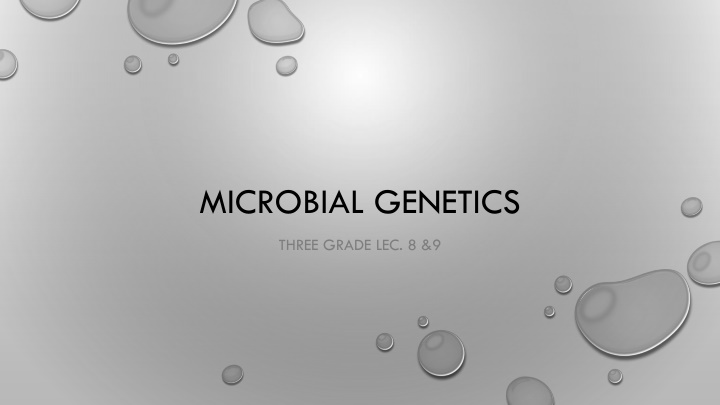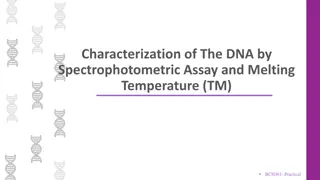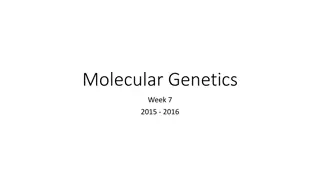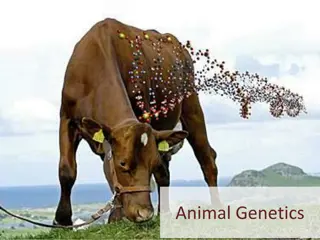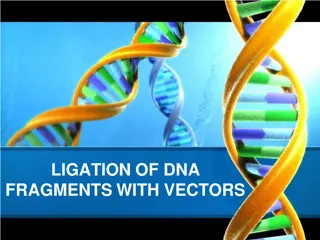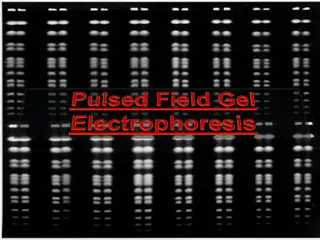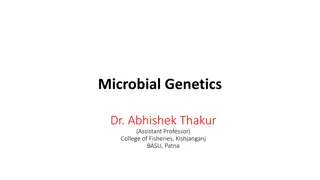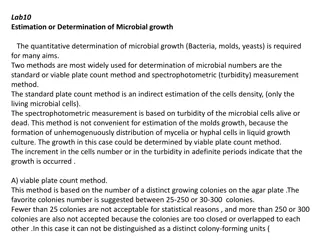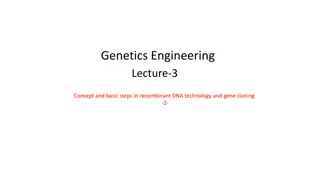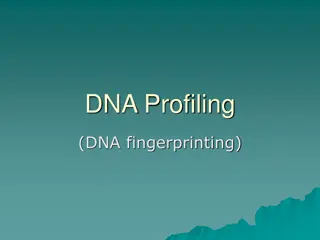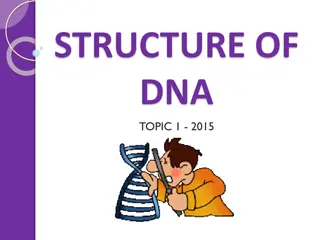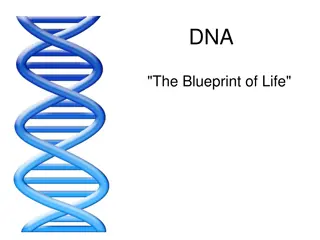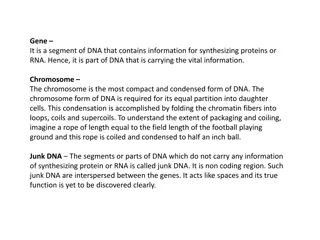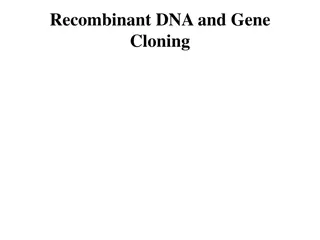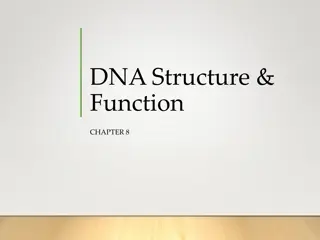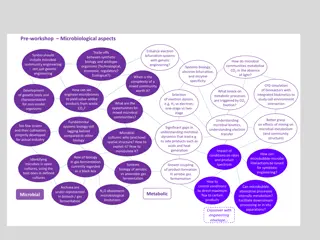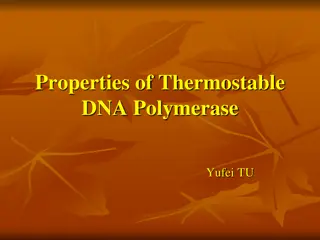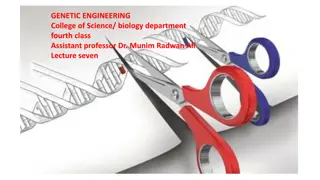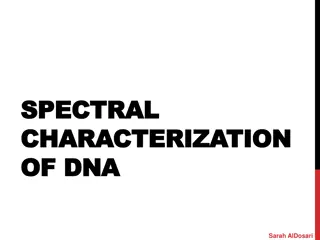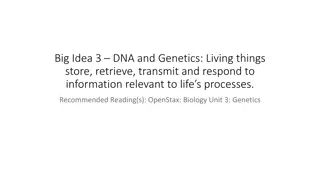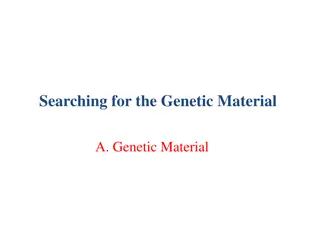Microbial Genetics: Transformation and Discovery of DNA Role
Transformation in microbial genetics involves the uptake of DNA from the environment, leading to genotype changes in cells. The discovery of transformation dates back to 1928, highlighting the role of DNA as the hereditary material. Competence, selective DNA uptake, and recombination play crucial roles in this process.
Download Presentation

Please find below an Image/Link to download the presentation.
The content on the website is provided AS IS for your information and personal use only. It may not be sold, licensed, or shared on other websites without obtaining consent from the author.If you encounter any issues during the download, it is possible that the publisher has removed the file from their server.
You are allowed to download the files provided on this website for personal or commercial use, subject to the condition that they are used lawfully. All files are the property of their respective owners.
The content on the website is provided AS IS for your information and personal use only. It may not be sold, licensed, or shared on other websites without obtaining consent from the author.
E N D
Presentation Transcript
MICROBIAL GENETICS THREE GRADE LEC. 8 &9
Transformation Transformation describes the uptake of naked DNA from the surrounding medium, and the change in genotype thus conferred upon the recipient cell the transformant. Transformation occurs naturally in many bacteria (e.g. Bacillus, Streptomyces and Haemophillus spp.) although competence (ability to take up exogenous DNA) is usually transient.
the discovery of transformation was in 1928 that Fred Griffith, working with pneumococcus (Streptococcus pneumoniae) discovered that a virulent strains could be restored to virulence by incubation with an extract from killed virulent cells. Sixteen years later, Avery, MacLeod and McCarty demonstrated that the transforming principle was DNA, which established the role of DNA as the hereditary material of the bacterial cell. Such naturally-occurring transformation has been most studied in Bacillus subtilis and Haemophilus influenzae (as well as S. pneumoniae) Although the number of species in which natural transformation has been demonstrated is still quite limited. Competence generally occurs at a specific stage of growth, most commonly in late log phase. This may be a response to cell density rather than (or as well as) growth phase. The development of competence at this stage is associated not only with nutrient depletion but also with the accumulation of specific secreted products (competence factors).
Following the development of competence, double- stranded DNA fragments bind to receptors on the cell surface, but only one of the strands enters the cell. In some species, the process is selective for DNA from the same species, through a requirement for short species- specific sequences. For example, the uptake of DNA by the meningococcus (Neisseria meningitidis) is dependent on the presence of a specific 10-bp uptake sequence. The genome of N. meningitidis contains nearly 2000 copies of this sequence, which will only occur infrequently and by chance, in other genomes.
On the other hand, B. subtilis and S. pneumoniae can take up virtually any linear DNA molecule. If the cell is to become transformed in a stable manner, the new DNA has to be replicated and inherited. As here fragments of chromosomal DNA (rather than plasmids) are being considered, replication of the DNA will only happen if the incoming DNA is recombined with the host chromosome. This requires homology between the transforming DNA and the recipient chromosome. there is enough similarity in some regions of the chromosome, those segments of DNA can still undergo recombination with the recipient chromosome. The closer the taxonomic relationship, the more likely it is that they will be sufficiently similar. One example of this, is the development of resistance to penicillin in S. pneumoniae. This occurred by the replacement of the genes coding for the penicillin target enzymes with corresponding DNA from naturally-resistant oral streptococci.
Natural transformation is of limited usefulness for artificial genetic modification of bacteria, mainly because it works best with linear DNA fragments rather than the circular plasmid DNA. For introducing foreign genes into a bacterial host a mixture of cells and DNA may be briefly subjected to a high voltage which enables the DNA to enter the cell (a process known as electroporation). Transduction Transduction is the process by which cellular genes can be transferred from a donor to a recipient cell by a virus particle (phage-mediated transfer), the recipient being known as a transductant following transfer . This process is normally highly specific for phage DNA. However, with some phages, errors can be made and fragments of bacterial DNA (produced by phage-mediated degradation of the host chromosome) are occasionally packaged by mistake leading to phage-like particles that contain a segment of bacterial genome . These transducing particles are capable of infecting a recipient cell. The transduced segment of DNA will therefore be injected into the new host cell. Not all bacteriophages are capable of carrying out transduction. The basic requirements of an effective transducing phage are that infection should result in an appropriate level of degradation of the chromosomal DNA to form suitably sized fragments at the right time for packaging.
In some cases, the transduced DNA is a bacterial plasmid, in which case the injected DNA molecule is capable of being replicated and inherited. More commonly the DNA incorporated into the transducing particle is a fragment of chromosomal DNA which will be unable to replicate in the recipient cell. For it to be replicated and inherited, it must be incorporated into the recipient chromosome (by recombination). This process is known as generalized transduction. homologous
Specialized transduction some phages (temperate phages) are able to establish a state known as lysogeny, in which expression of phage genes and replication of the phage is repressed. In many cases the prophage is inserted into the bacterial DNA and replicates as part of the chromosome. When lysogeny breaks down and the phage enters the lytic cycle, it is excised from the chromosome by recombination between sequences at each end of the integrated prophage. If this recombination event happens in the wrong place, an adjacent region of bacterial DNA is incorporated into the phage DNA. Since the DNA transferred is limited to a very small region of the chromosome, the phenomenon is known as specialized (or restricted) transduction.
Recombination General (homologous) recombination A common feature of all the forms of gene transfer between bacteria, except for the transfer of plasmids (which can replicate independently), is the requirement for the transferred piece of DNA to be inserted into the recipient chromosome by breaking both DNA molecules, crossing them over and rejoining them. This process, known as recombination. There are several different forms of recombination, but the mechanisms that require the presence of homologous regions of DNA which must be highly similar. It is therefore known as homologous recombination. Site-specific and non-homologous (illegitimate) recombination Does not require homology between recombining partners. The proteins mediating this process (site-specific recombinases) recognize short, specific DNA sequences in the donor and recipient molecules, and interaction between the proteins facilitates recombination. Homology often exists between the donor and recipient sites because the same recombinase protein binds to both recognition sites.
